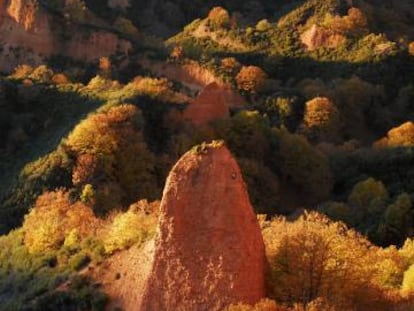Ten fabulous fall getaways
When the weather gets cooler, Spain’s forests explode in a display of reds and yellows
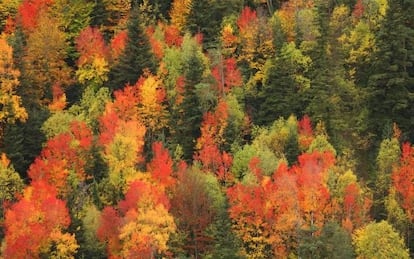
1 Ambroz Valley
CÁCERES
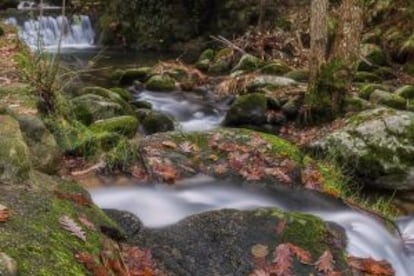
The valley of Ambroz, in northern Cáceres province, has mountains rising over 2,000 meters above sea level in a landscape where fertile plains give way to pasture land, gorges and rivers. A new hiking trail is available this season, along with a complete fall program filled with guided tours, adventure tourism, children’s activities, a foot race and a mountain bike outing.
2 Selva de Irati
NAVARRE

To travel to the western Pyrenees in Navarre and enter the Selva de Irati is to join a dance of reds, oranges, yellows, browns and the unwavering greens of the moss and the firs. The second-largest and best-preserved beech and fir forest in Europe after the Black Forest in Germany welcomes visitors with a carpet of leaves and mushrooms ready for picking, although this requires a daily or seasonal license.
3 Faedo de Ciñera
LEÓN

This ancient beech forest in Ciñera de Gordón, in the Central Mountain of León, took the prize for Best Preserved Forest in Spain in 2007, awarded by the Forests without Borders association in partnership with the Biodiversity Foundation. This place is home to Fagus, a beech tree that is over 500 years old and whose leaves, like its fellow beeches around it, turn yellow every autumn. To cross the forest and back –a 10-kilometer walk – is to recreate the path once taken by miners in Villar del Río to reach the coal mines of Ciñera.
4 Vineyards in La Rioja
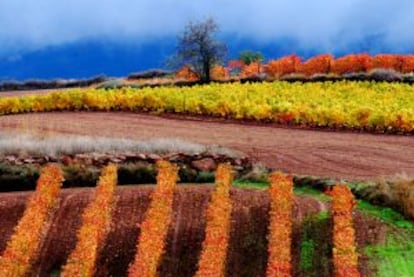
The time has come for the grape harvest, and some wineries in La Rioja let visitors participate by crushing the grapes, eating inside a guardaviñas (a stone building used as a shelter by farmers during bad weather) and even make their own grape juice. Visitors should take the time to contemplate the explosion of reds, ochres, oranges and yellows that the vineyards display before ending the season.
5 Muniellos Forest
ASTURIAS
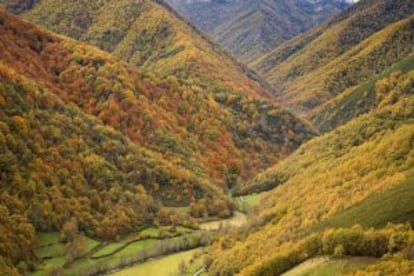
The first leaves to change color are the beech leaves, followed by the firs and the oak. This three-act show takes place inside the natural preserve of Muniellos, in southwestern Asturias, between Cangas del Narcea and Ibias. This is the largest oak forest in Spain and one of the best-preserved in Europe, and visits are restricted to no more than 20 people a day after getting authorization from the Asturias department of environmental affairs.
6 La Granja de San Ildefonso
SEGOVIA
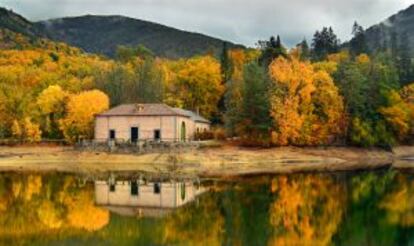
Poplars, willows, elm, lime trees, horse chestnuts, hornbeams, ash, maple, giant sequoias, oak, whitebeam, wild cherry trees, crab apple trees, fern, blackthorn, wild roses, honeysuckle...Together with the spring, autumn is the best time of the year to visit the gardens of the royal palace at La Granja de San Ildefonso, in Segovia. Its 146 hectares are dotted with 26 ornamental fountains, representing one of the best examples of garden design from 18th-century Europe.
7 Beech forest of Tejera Negra
GUADALAJARA

Europe’s southernmost beech forest, Tejera Negra, is part of the natural park of Sierra Norte in Guadalajara. It is nestled between two valleys flanked by rocky crags and fed by the Lillas and Zarzas rivers, which flow out of La Buitrera glacier. In the fall, the ochre-tinged leaves that fall to the ground cover the moss and fungi like Boletus edulis. There are two circular walking trails, Senda del Robledal and Senda de Carretas, and a third one for bicycles that reaches the Zarzas.
8 Montseny Natural Park
BARCELONA AND GIRONA
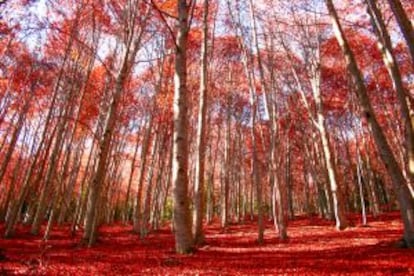
Imagine that the Montseny massif, located 50 kilometers from Barcelona, is a building made up of several layered habitats that change as the altitude rises. The lower layers are home to Mediterranean ecosystems (holm oak, cork oak, pine), the central part showcases oak, and above 1,000 meters there is a predominance of beech and fir. Riverside vegetation dominates the bottom of the valleys, while shrubs and meadows are ubiquitous on the summits. A biosphere reserve, Montseny Natural Park draws from a spectacular palette of colors.
9 Gorbeia Natural Park
ÁLAVA AND BIZKAIA

The peak of Gorbeia looks down on more than 20,000 hectares of land filled with beech, oak, alder, willow, ash and poplar. Located betwen the provinces of Álava and Bizkaia, it is the biggest natural park in the Basque Country. Of particular interest in the fall is the small beech forest of Otzarreta and, if the season is rainy, the 105-meter high waterfall of Goiuri.
10 Ordesa National Park
HUESCA
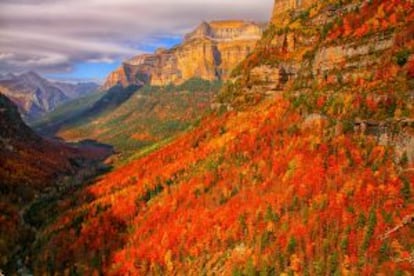
The exuberant mixed forest of beech, oak, rowan, birch and maple inside the national park of Ordesa y Monte Perdido, in Huesca province, provides one of the most colorful autumn postcards in all of Spain. The park boasts four valleys created by glaciers: Ordesa, Pineta, Escuaín and Añisclo. It is a good idea to wait until late October to see the forest in all of its splendor. The website Ordesa.com has organized a photo contest, Ordesa en otoño, asking contestants to capture the best fall moment.
English version by Susana Urra.
Tu suscripción se está usando en otro dispositivo
¿Quieres añadir otro usuario a tu suscripción?
Si continúas leyendo en este dispositivo, no se podrá leer en el otro.
FlechaTu suscripción se está usando en otro dispositivo y solo puedes acceder a EL PAÍS desde un dispositivo a la vez.
Si quieres compartir tu cuenta, cambia tu suscripción a la modalidad Premium, así podrás añadir otro usuario. Cada uno accederá con su propia cuenta de email, lo que os permitirá personalizar vuestra experiencia en EL PAÍS.
¿Tienes una suscripción de empresa? Accede aquí para contratar más cuentas.
En el caso de no saber quién está usando tu cuenta, te recomendamos cambiar tu contraseña aquí.
Si decides continuar compartiendo tu cuenta, este mensaje se mostrará en tu dispositivo y en el de la otra persona que está usando tu cuenta de forma indefinida, afectando a tu experiencia de lectura. Puedes consultar aquí los términos y condiciones de la suscripción digital.
More information
Archived In
Últimas noticias
Most viewed
- Reinhard Genzel, Nobel laureate in physics: ‘One-minute videos will never give you the truth’
- Oona Chaplin: ‘I told James Cameron that I was living in a treehouse and starting a permaculture project with a friend’
- Pablo Escobar’s hippos: A serious environmental problem, 40 years on
- Why we lost the habit of sleeping in two segments and how that changed our sense of time
- Chevy Chase, the beloved comedian who was a monster off camera: ‘Not everyone hated him, just the people who’ve worked with him’

